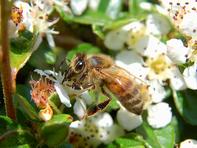Apart from registering their hives, there are certain requirements for beekeepers to provide pollination services to food crops. Agricultural Research Council (ARC) researcher Mike Allsopp recommends the following pollination guidelines for beekeepers providing pollination services: Colonies used for pollination must be queen-right (have a queen in the hive).

Hives should have at least 8 brood frames covered with bees and 4 brood frames with the brood at different stages. Colonies should be placed in groups, preferably forming a circle to limit drifting. One site should be no more than 400 m from the next. If this can't be done, they should be placed along the edge of the orchard or field.
When the colonies are placed in a line it is best to stagger them as much as possible and turn every second entrance 180°. Hives should be placed on low stands such as bricks to keep away from soil moisture. In areas with honey badgers set them at least 1 m high, colonies must also be protected against ants.
If there are competitive bee-plants in or near the orchard (eucalyptus, citrus, lucerne, acacias etc) increase the number of colonies. Ensure that fresh water is near throughout the year. It is vital to maintaining the required humidity and temperature in the hive for brood rearing. For most crops, colonies can be moved into the orchard or field when 10% of all flowers have already opened.
Commercial pollination can be rather complicated and demands research and experience. Local bee farmer associations might be valuable in terms of recommendations and help.
Pollination of Food Crops

In South Africa, pollen research is conducted by the ARC, which has supplied the following recommendations for the pollination of food crops:
Almonds: Planted mainly in the Western Cape, this nut tree flowers for 21 days. Place 5 - 8 hives/ha when trees are 50% in flower. Almond flowers are most receptive on the second open day.
Apples: Planted mainly in the Western Cape, individual apple trees flower for 10 to 25 days. For good pollination of apple trees, 2 - 5 hives/ha is recommended. Good tree coverage by bees is achieved if 3 or more bees per tree at any time of the day are counted.
Avocados: Avocados are not wind-pollinated so require the active transfer of pollen by insects of which bees are by far the best pollinators. It was found that bees can be lured away by competitive bee-plants such as blackjacks, late flowering saligna gums (a type of eucalyptus tree) and early flowering citrus. Effective pollination of avocados requires 2 - 4 hives/ha and about 5 bees (counted between 10:00 and 16:00) per 1 m² of the flowering tree.
Blueberries: With a huge growth in blueberry plantings in Southern Africa expected from 2018 to 2023, pollination services for blueberries will be in huge demand. Plantings are estimated to grow from 1 500 ha to 6 000 ha. Blueberries flower for a long time so it is a good idea to bring fresh bees in every 2 - 3 weeks. Place 10 - 14 colonies.
Canola: Canola is mainly planted for oil (South-Western Cape) and on small scale for seed production (Free State and Northern Cape). The quality and quantity of seeds are greatly increased by honey bee pollination. Canola flowers for 5 - 7 weeks. Two - 6 hives/ha are recommended. Honey must be extracted as soon as possible because canola honey crystallizes quickly in the comb.
Litchis: Litchi trees are planted in the subtropical regions of South Africa and flowers for up to 21 days. Pollination by bees is essential for lichi fruit set and 2 - 4 hives are set inside the orchard. Colony strength increases during the pollination period and swarms may become more defensive - place hives away from orchard staff.
Macadamia nuts: Macadamias are the fastest-growing tree crop industry in South Africa and therefore good news for beekeepers who want to provide pollination services for macadamia nut farmers. Macadamias flower for long periods, so it is generally a good idea to bring in fresh waves of bees, perhaps every 2-3 weeks. Place 5 - 8 hives/ha.
Mangoes: An important subtropical crop in South Africa, mango trees flower for 28 days. The pollination recommendation is 3 - 15 hives/ha. Colony strengths decline during the mango pollination period, therefore strong and healthy swarms are required.
Onions: For onions to produce seed, pollination by bees is required. Five to 12 hives/ha is recommended. In onions, bees can be sensitive to the banded bee pirate (often found in sandy areas) and the potassium content in onion nectar.
Plums: Planted in the Western Cape, plum trees flower for between 8 and 14 days, but the flower is receptive for 1 - 2 days. It is recommended that 2 - 6 hives/ha be used and the hives moved when crops are sprayed with pesticides.
By Marinda Louw